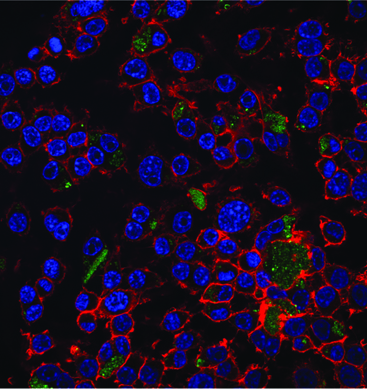An intriguing image for November comes from biomedical engineer Mike Davis’ lab, courtesy of BME graduate student Inthirai Somasuntharam.
Each year, thousands of children undergo surgery for congenital heart defects. A child’s heart is more sensitive to injury caused by interrupting blood flow during surgery, and excess reactive oxygen species are a key source of this damage.

Macrophages with blue nuclei and red cytoskeletons, being treated with green nano particles. The particles carry RNA that shut off reactive oxygen species production.
Davis and his colleagues are able to shut off cheap oakley reactive oxygen species at the source by targeting the NOX (NADPH oxidase*) enzymes that produce them. This photo, from a 2013 Biomaterials paper, shows green fluorescent nanoparticles carrying small interfering RNA. The RNA precisely shuts down one particular gene encoding a NOX enzyme. Eventually, similar nanoparticles may shield the heart from damage during pediatric heart surgery.
In the paper, Somasuntharam used particles made of a slowly dissolving polymer called polyketals. The particles delivered fragile but potent RNA molecules into macrophages, inflammatory cells that swarm into cardiac tissue after a heart attack. Davis and Georgia Tech colleague Niren Murthy previously harnessed this polymer to deliver drugs that can be toxic to the rest of the body.
The polyketal particles are especially well-suited for delivering a payload to macrophages, since those types of cells (as the name implies) are big eaters. Davis reports his lab has been working on customizing the particles so they can deliver RNA molecules into cardiac muscle cells as well.
*While we’re on the topic of NADPH oxidases, Susan Smith and David Lambeth have been looking for and finding potential drugs that inhibit them.

